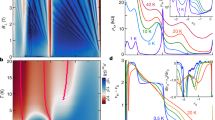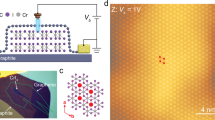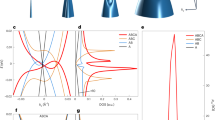Abstract
Magnetism typically arises from the effect of exchange interactions on highly localized fermionic wavefunctions in f- and d-atomic orbitals. By contrast, in rhombohedral multilayer graphene (RMG), magnetism—manifesting as spontaneous polarization into one or more spin and valley flavours1,2,3,4,5,6,7—originates from itinerant electrons near a Van Hove singularity. Here we show experimentally that the electronic entropy in this system indicates signatures typically associated with disordered local magnetic moments, unexpected for electrons in a fully itinerant metal. Specifically, we find a contribution ΔS ≈ 1 kB per charge carrier that begins at the Curie temperature and survives more than one order of magnitude in temperature. First-order phase transitions show an isospin ‘Pomeranchuk effect’ in which the fluctuating moment phase is entropically favoured over the nearby symmetric Fermi liquid8,9. Our results imply that, despite the itinerant nature of the electron wavefunctions, the spin and valley polarization of individual electrons is decoupled, a phenomenon typically associated with localized moments, as happens, for example, in solid 3He (ref. 10). Transport measurements, surprisingly, show a finite-temperature resistance minimum in the fluctuating moment regime, which we attribute to the interplay of fluctuating magnetic moments and electron–phonon scattering. Our results highlight the universality of soft isospin modes to two-dimensional flat-band systems.
This is a preview of subscription content, access via your institution
Access options
Access Nature and 54 other Nature Portfolio journals
Get Nature+, our best-value online-access subscription
$32.99 / 30 days
cancel any time
Subscribe to this journal
Receive 51 print issues and online access
$199.00 per year
only $3.90 per issue
Buy this article
- Purchase on SpringerLink
- Instant access to full article PDF
Prices may be subject to local taxes which are calculated during checkout



Similar content being viewed by others
Data availability
The experimental data used in this work are available from Zenodo at https://doi.org/10.5281/zenodo.14641744 (ref. 55). The source data are also provided with this article.
References
Shi, Y. et al. Electronic phase separation in multilayer rhombohedral graphite. Nature 584, 210–214 (2020).
Zhou, H. et al. Half- and quarter-metals in rhombohedral trilayer graphene. Nature 598, 429–433 (2021).
Zhou, H. et al. Isospin magnetism and spin-polarized superconductivity in Bernal bilayer graphene. Science 375, 774–778 (2022).
de la Barrera, S. C. et al. Cascade of isospin phase transitions in Bernal-stacked bilayer graphene at zero magnetic field. Nat. Phys. 18, 771–775 (2022).
Seiler, A. M. et al. Quantum cascade of correlated phases in trigonally warped bilayer graphene. Nature 608, 298–302 (2022).
Han, T. et al. Orbital multiferroicity in pentalayer rhombohedral graphene. Nature 623, 41–47 (2023).
Zhang, Y. et al. Enhanced superconductivity in spin–orbit proximitized bilayer graphene. Nature 613, 268–273 (2023).
Saito, Y. et al. Isospin Pomeranchuk effect in twisted bilayer graphene. Nature 592, 220–224 (2021).
Rozen, A. et al. Entropic evidence for a Pomeranchuk effect in magic-angle graphene. Nature 592, 214–219 (2021).
Pomeranchuk, I. On the theory of liquid 3-He. Zh. Eksp. Teor. Fiz. 20, 919–926 (1950).
Santiago, J. M., Huang, C. L. & Morosan, E. Itinerant magnetic metals. J. Phys. Condens. Matter 29, 373002 (2017).
Moriya, T. Spin Fluctuations in Itinerant Electron Magnetism (Springer, 1985).
Cao, Y. et al. Unconventional superconductivity in magic-angle graphene superlattices. Nature 556, 43–50 (2018).
Sharpe, A. L. et al. Emergent ferromagnetism near three-quarters filling in twisted bilayer graphene. Science 365, 605–608 (2019).
Chen, G. et al. Evidence of a gate-tunable Mott insulator in a trilayer graphene moiré superlattice. Nat. Phys. 15, 237–241 (2019).
Serlin, M. et al. Intrinsic quantized anomalous Hall effect in a moiré heterostructure. Science 367, 900–903 (2020).
Lu, Z. et al. Fractional quantum anomalous Hall effect in multilayer graphene. Nature 626, 759–764 (2024).
Cai, J. et al. Signatures of fractional quantum anomalous Hall states in twisted MoTe2. Nature 622, 63–68 (2023).
Zeng, Y. et al. Thermodynamic evidence of fractional Chern insulator in moiré MoTe2. Nature 622, 69–73 (2023).
Wu, F., Lovorn, T., Tutuc, E. & Macdonald, A. H. Hubbard model physics in transition metal dichalcogenide moiré bands. Phys. Rev. Lett. 121, 26402 (2018).
Song, Z. D. & Bernevig, B. A. Magic-angle twisted bilayer graphene as a topological heavy fermion problem. Phys. Rev. Lett. 129, 47601 (2022).
Tang, Y. et al. Simulation of Hubbard model physics in WSe2/WS2 moiré superlattices. Nature 579, 353–358 (2020).
Shi, H. & Dai, X. Heavy-fermion representation for twisted bilayer graphene systems. Phys. Rev. B 106, 245129 (2022).
Hu, H. et al. Symmetric Kondo lattice states in doped strained twisted bilayer graphene. Phys. Rev. Lett. 131, 166501 (2023).
Hu, H., Bernevig, B. A. & Tsvelik, A. M. Kondo lattice model of magic-angle twisted-bilayer graphene: Hund’s rule, local-moment fluctuations, and low-energy effective theory. Phys. Rev. Lett. 131, 26502 (2023).
Datta, A., Calderón, M. J., Camjayi, A. & Bascones, E. Heavy quasiparticles and cascades without symmetry breaking in twisted bilayer graphene. Nat. Commun. 14, 5036 (2023).
Chou, Y. Z. & Das Sarma, S. Kondo lattice model in magic-angle twisted bilayer graphene. Phys. Rev. Lett. 131, 26501 (2023).
Lau, L. L. H. & Coleman, P. Topological mixed valence model for twisted bilayer graphene. Preprint at https://arxiv.org/abs/2303.02670 (2025).
Zhou, G. D., Wang, Y. J., Tong, N. & Song, Z. D. Kondo phase in twisted bilayer graphene. Phys. Rev. B 109, 45419 (2024).
Ledwith, P. J., Dong, J., Vishwanath, A. & Khalaf, E. Nonlocal moments in the Chern bands of twisted bilayer graphene. Preprint at https://arxiv.org/abs/2408.16761 (2025).
Zhou, H., Xie, T., Taniguchi, T., Watanabe, K. & Young, A. F. Superconductivity in rhombohedral trilayer graphene. Nature 598, 434–438 (2021).
Holleis, L. et al. Nematicity and orbital depairing in superconducting Bernal bilayer graphene. Nat. Phys. https://doi.org/10.1038/s41567-024-02776-7 (2025).
Seiler, A. M. et al. Interaction-driven quasi-insulating ground states of gapped electron-doped bilayer graphene. Phys. Rev. Lett. 133, 066301 (2024).
Li, C. et al. Tunable superconductivity in electron- and hole-doped Bernal bilayer graphene. Nature 631, 300–306 (2024).
Han, T. et al. Correlated insulator and Chern insulators in pentalayer rhombohedral-stacked graphene. Nat. Nanotechnol. 19, 181–187 (2024).
Arp, T. et al. Intervalley coherence and intrinsic spin–orbit coupling in rhombohedral trilayer graphene. Nat. Phys. 20, 1413–1420 (2024).
Xie, T. et al. Optical imaging of flavor order in flat band graphene. Preprint at https://arxiv.org/abs/2405.08074 (2024).
Hunt, B. M. et al. Direct measurement of discrete valley and orbital quantum numbers in bilayer graphene. Nat. Commun. 8, 948 (2017).
Fiete, G. A. Colloquium: The spin-incoherent Luttinger liquid. Rev. Mod. Phys. 79, 801–820 (2007).
Andreev, A. F. & Kosevich, Y. A. Kinetic phenomena in semiquantum liquids. Zh. Eksp. Teor. Fiz. 50, 12518–2523 (1979).
Vollhardt, D. Normal 3He: an almost localized Fermi liquid. Rev. Mod. Phys. 56, 99–120 (1984).
Davis, S. M., Chou, Y.-Z., Wu, F. & Das Sarma, S. Phonon-limited resistivity of multilayer graphene systems. Phys. Rev. B 107, 045426 (2023).
Polshyn, H. et al. Large linear-in-temperature resistivity in twisted bilayer graphene. Nat. Phys. 15, 1011–1016 (2019).
Cao, Y. et al. Strange metal in magic-angle graphene with near Planckian dissipation. Phys. Rev. Lett. 124, 76801 (2020).
Jaoui, A. et al. Quantum critical behaviour in magic-angle twisted bilayer graphene. Nat. Phys. 18, 633–638 (2022).
Gurzhi, R. Hydrodynamic effects in solids at low temperature. Sov. Phys. Usp. 11, 255 (1968).
Colvin, R. V., Legvold, S. & Spedding, F. H. Electrical resistivity of the heavy rare-earth metals. Phys. Rev. 120, 741–745 (1960).
Fisher, M. E. & Langer, J. S. Resistive anomalies at magnetic critical points. Phys. Rev. Lett. 20, 665–668 (1968).
Panigrahi, A. & Levitov, L. Signatures of electronic ordering in transport in graphene flat bands. Phys. Rev. B 110, 035122 (2024).
Vafek, O. & Kang, J. Renormalization group study of hidden symmetry in twisted bilayer graphene with Coulomb interactions. Phys. Rev. Lett. 125, 257602 (2020).
Khalaf, E., Bultinck, N., Vishwanath, A. & Zaletel, M. P. Soft modes in magic angle twisted bilayer graphene. Preprint at https://arxiv.org/abs/2009.14827 (2020).
Kumar, A., Xie, M. & Macdonald, A. H. Lattice collective modes from a continuum model of magic-angle twisted bilayer graphene. Phys. Rev. B 104, 035119 (2021).
Vituri, Y., Xiao, J., Pareek, K., Holder, T. & Berg, E. Incommensurate intervalley coherent states in ABC graphene: collective modes and superconductivity. Phys. Rev. B 111, 075103 (2025).
Wolf, T., Wei, N., Zhou, H. & Huang, C. Magnetism in the dilute electron gas of rhombohedral multilayer graphene. Preprint at https://arxiv.org/abs/2408.15884 (2024).
Holleis, L. et al. Source data of: Fluctuating magnetism and Pomeranchuk effect in multilayer graphene. Zenodo https://doi.org/10.5281/zenodo.14641743 (2025).
Acknowledgements
We acknowledge discussions with A. Bernevig, T. Senthil and T. Wang. A.F.Y. acknowledges the primary support of the National Science Foundation under award DMR-2226850 with additional support provided by the Gordon and Betty Moore Foundation under award GBMF9471. C.J. acknowledges support from the Air Force Office of Scientific Research under award FA9550-23-1-0117. We acknowledge the use of shared facilities made available by the support of the National Science Foundation through Enabling Quantum Leap: Convergent Accelerated Discovery Foundries for Quantum Materials Science, Engineering and Information (Q-AMASE-i) award number DMR-1906325. The work at MIT was supported by the Science and Technology Center for Integrated Quantum Materials, National Science Foundation grant no. DMR-1231319 and was performed in part at Aspen Center for Physics, which is supported by National Science Foundation grant no. PHY-2210452. K.W. and T.T. acknowledge support from the Elemental Strategy Initiative conducted by the Ministry of Education, Culture, Sports, Science and Technology, Japan (grant no. JPMXP0112101001) and JSPS KAKENHI (grant nos. 19H05790, 20H00354 and 21H05233). E.B. was supported by NSF-BSF award DMR-2310312 and by the European Research Council under grant HQMAT (grant agreement no. 817799).
Author information
Authors and Affiliations
Contributions
A.F.Y. conceived and directed the project. L.H., T.X., S.X. and H.Z. designed and fabricated the devices. K.W. and T.T. grew the hexagonal boron nitride crystals. L.H., C.L.P. and A.F.Y. performed the transport and capacitance measurements and analysed the data. T.X., S.X. and C.J. performed the optics measurements. L.H., A.P., L.S.L., E.B. and A.F.Y. interpreted the data. L.H., L.S.L., E.B. and A.F.Y. wrote the manuscript, with input from the other authors.
Corresponding author
Ethics declarations
Competing interests
The authors declare no competing interests.
Peer review
Peer review information
Nature thanks the anonymous reviewers for their contribution to the peer review of this work. Peer reviewer reports are available.
Additional information
Publisher’s note Springer Nature remains neutral with regard to jurisdictional claims in published maps and institutional affiliations.
Extended data figures and tables
Extended Data Fig. 1 Optically detected flavour polarization in R3G.
a, Measurement schematic of the optical probe technique. A WSe2 sensing layer is directly in contact with R3G and its exciton energy is used as a probe of the Fermi surface reconstructions in R3G. b, Reflection contrast of the R3G/WSe2 heterostructure near WSe2 2s exciton resonance, as a function of ne at D = 0.75 V nm−1 and T = 2 K. c, Derivative with respect to energy E of the data in panel b. d, Extracted 2s exciton energy at different temperatures. The energy shift ΔE is measured relative to charge neutrality of the R3G layer, with individual curves offset by 4 meV for clarity.
Extended Data Fig. 2 Extracting ΔS from κ(T) in R2G.
a, High-resolution measurement of κ = ∂μ/∂ne for different temperatures at D = 0.5 V nm−1. b, The difference in κ between pairs of temperatures, \(\Delta \kappa \times {({T}_{{\rm{H}}}-{T}_{{\rm{L}}})}^{-1}=\)\((\kappa ({T}_{{\rm{H}}})-\kappa ({T}_{{\rm{L}}}))/\Delta T\approx {{\rm{d}}}^{2}S/{\rm{d}}{n}_{{\rm{e}}}^{2}\) measured at high |ne|, at which no broken symmetries are observed at low temperature. c, \({{\rm{d}}}^{2}S/{\rm{d}}{n}_{{\rm{e}}}^{2}\) in the low-|ne| regime of broken symmetries. d, Data from panel b integrated with respect to ne to give dS/dne. The bounds of integration are −1.25 × 1012 cm−2 and −0.55 × 1012 cm−2. e, Data from panel c integrated with respect to ne to give dS/dne. The bounds of integration are −0.55 × 1012 cm−2 and 0, chosen to correspond to the band edge at low |ne|, the onset of appreciable Δκ at high |ne|. f, Data in panel d integrated with respect to ne to give ΔS. The entropy is found to be ΔS ≪ 0.1 kB throughout this range. g, Data in panel e integrated with respect to ne to give ΔS. These data are shown in the main text as Fig. 2a. The grey lines in panels f and g show the Fermi liquid entropy ΔSFL calculated from single-particle band structure at finite temperature T = 2 K. Evidently, the measured entropy at finite displacement field exceeds the theoretical expectations of a degenerate Fermi liquid by more than an order of magnitude. Details about this data analysis are given in Methods.
Extended Data Fig. 3 Entropy analysis for different temperatures and displacement fields.
a, Comparison of the measured entropy presented in the main text (Fig. 2a) with two further datasets taken at TH = 3 K, TL = 2 K and TH = 11 K, TL = 10 K. Both measurements are in good agreement with those taken over larger temperature ranges, underlining that the excess entropy is almost temperature-independent. b, In-plane magnetic-field dependence of the entropy at higher temperatures extracted from data taken at TH = 10 K, TL = 6 K. The entropy suppression at higher temperatures is much smaller than in the low-temperature data presented in Fig. 2b, as expected. c, Excess entropy ΔS for three different displacement fields. The entropy is measured for the temperature interval TH = 1.5 K and TL = 20 mK. The entropy value is found to be approximately independent of the displacement field.
Extended Data Fig. 4 Extracting ΔM from κ(B) in R2G.
a, High-resolution measurement of κ = ∂μ/∂ne for in-plane fields of 0 and 4 T at D = 0.5 V nm−1 and T = 1.5 K. b, \({{\rm{d}}}^{2}M/{\rm{d}}{n}_{{\rm{e}}}^{2}=-\,\Delta \kappa /\Delta B=-\,(\kappa ({B}_{{\rm{H}}})-\kappa ({B}_{{\rm{L}}}))/\Delta B\) measured for BH = 4 T and BL = 0 T. c, Data from panel b integrated with respect to |ne| to give dM/dne. d, Data from panel c integrated with respect to |ne| to give ΔM. The detailed analysis process is described in Methods.
Extended Data Fig. 5 Chemical potential discontinuity at the first-order phase PIP1 to Sym12 transition in R2G.
a, κ at D = 0.8 V nm−1 in the vicinity of the PIP1 to Sym12 transition. b, Δμ corresponds to the area of the negative dip in κ. We linearly extrapolate κ in the adjacent phases (dashed lines) and set the bounds of integration at which the measured data deviate from the linear trend by more than 3σ, for which σ is the standard deviation of the measurement. The resulting bounds are indicated by the red crosses. Data here are acquired at 20 mK, with the shaded area corresponding to the measured Δμ. c, The same analysis for data acquired at 1.5 K. d, κ with the trend line of the PIP1 phase subtracted. The grey-shaded region is centred at −3σ and has a width of σ; error bars in Δμ are obtained by propagating the uncertainty in determining the bounds indicated by the error bar. e, The same analysis as in panel d but with the Sym12 phase subtracted.
Extended Data Fig. 6 Movement of phase transitions with temperature and in-plane field in R2G.
a, Density- and temperature-dependent penetration field capacitance at D = 0.8 V nm−1. b,c, In-plane magnetic field dependence at 0.02 K and 1.7 K, respectively and D = 0.8 V nm−1. The white dots mark minima in capacitance, which correspond to first-order phase transitions at lowest temperatures and show the strong dependence on T and B∥.
Extended Data Fig. 7 Negative dR/dT in R3G.
a, ne, D phase diagram at T = 6 K. b–e, Temperature-dependent resistance measurements for different densities and displacement fields. The different lines are colour-coded corresponding to the diamonds in panel a. A finite-temperature minimum is observed in the fluctuation regime, whereas such behaviour is absent if the ground state is symmetric in the isospin space.
Extended Data Fig. 8 Negative dR/dT in sample with hBN-R2G moiré sample.
a, Sample micrograph. Scale bar, 5 μm. The current flow and four-terminal measurement configuration is indicated. b, Sample schematic of the double hBN-aligned device. c, Rxx as a function of density at T = 1.6 K. The moiré peaks of both top and bottom hBN are labelled accordingly, with the green arrows indicating the supermoiré peaks at low densities owing to double alignment. Temperature-dependent resistance measurements for decreasing densities at D = 0 V nm−1 (d) and 0.6 V nm−1 (e).
Extended Data Fig. 9 Evolution of negative dR/dT with in-plane field in R2G.
a, Density-dependent resistance measurements at 1.7 K and different in-plane magnetic fields. b, B∥ dependence at 1.7 K for different densities. Temperature-dependent resistance data for different values of B∥ at ne = −0.1 × 1012 cm−2 (c), ne = −0.25 × 1012 cm−2 (d) and ne = −0.45 × 1012 cm−2 (e). Although the finite-temperature resistance minimum is almost unaffected by the in-plane magnetic field, larger magnetoresistance is observed below Tmin, depending on the low-temperature phases.
Supplementary information
Rights and permissions
Springer Nature or its licensor (e.g. a society or other partner) holds exclusive rights to this article under a publishing agreement with the author(s) or other rightsholder(s); author self-archiving of the accepted manuscript version of this article is solely governed by the terms of such publishing agreement and applicable law.
About this article
Cite this article
Holleis, L., Xie, T., Xu, S. et al. Fluctuating magnetism and Pomeranchuk effect in multilayer graphene. Nature 640, 355–360 (2025). https://doi.org/10.1038/s41586-025-08725-5
Received:
Accepted:
Published:
Issue date:
DOI: https://doi.org/10.1038/s41586-025-08725-5



